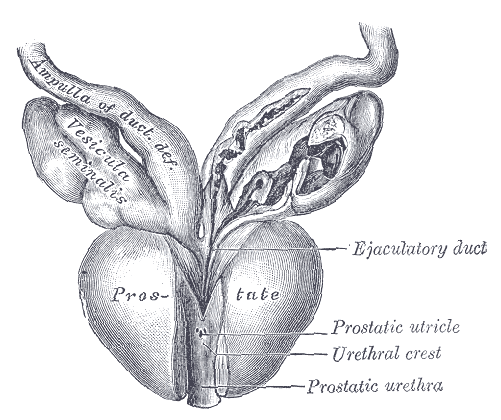
Anatomy
Abdomen
Which of the following best describes the relationship of the bladder and prostate gland:
Answer:
The prostate lies immediately inferior to the bladder and the internal urethral sphincter, superior to the external urethral sphincter (with the levator ani lying inferolaterally to the gland) and anterior to the rectum.Prostate
Anatomy / Abdomen / Male Reproductive System
Last Updated: 11th April 2019
The prostate is an unpaired accessory structure of the male reproductive system that surrounds the prostatic urethra in the pelvic cavity. It typically weighs between 20 - 40 g with an average size of 4 x 3 x 2 cm (its width being the greatest).
Function
Secretions from the prostate, together with secretions from the seminal vesicle, contribute to the formation of semen during ejaculation.
The prostatic ducts open into the floor of the prostatic portion of the urethra.
The ejaculatory ducts (formed from the union of the ductus deferens with the duct of the seminal gland) pass almost vertically in an anteroinferior direction through the posterior aspect of the prostate to open into the prostatic urethra.

Ejaculatory Ducts Opening into the Prostate. (Image by Henry Vandyke Carter [Public domain])
Relations
The prostate lies immediately inferior to the bladder and the internal urethral sphincter, superior to the external urethral sphincter (with the levator ani muscle lying inferolaterally to the gland) and anterior to the rectum. The urethra passes through the prostate.

Male Reproductive System. (Image by CFCF (Own work) [CC BY-SA 3.0 , via Wikimedia Commons)
Structure
Traditionally the prostate gland is divided anatomically into lobules, but more important clinically is specific anatomical zones rather than lobes:
- The transitional zone is the most central part of the gland that surrounds the prostatic urethra and the area most prone to prostatic hyperplasia, resulting in urinary symptoms.
- The central zone encircles the transitional zone and encompasses the ejaculatory ducts posterior to the prostatic urethra.
- The peripheral zone is the outermost region of the prostate and the area most prone to carcinomatous transformation. This is the zone palpated on PR examination.
![Modified by FRCEM Success. Original by Unknown Illustrator [Public domain or Public domain], via Wikimedia Commons](https://primary-cdn.frcemsuccess.com/wp-content/uploads/2017/02/Prostate.jpg)
Zones of the Prostate. (Image modified by FRCEM Success. Original by Unknown Illustrator [Public domain or Public domain], via Wikimedia Commons)
Lymphatic Drainage
The prostate gland has several lymphatic drainage pathways primarily to the internal iliac nodes with some drainage to external iliac and presacral nodes.
Report A Problem
Is there something wrong with this question? Let us know and we’ll fix it as soon as possible.
Loading Form...
- Biochemistry
- Blood Gases
- Haematology
| Biochemistry | Normal Value |
|---|---|
| Sodium | 135 – 145 mmol/l |
| Potassium | 3.0 – 4.5 mmol/l |
| Urea | 2.5 – 7.5 mmol/l |
| Glucose | 3.5 – 5.0 mmol/l |
| Creatinine | 35 – 135 μmol/l |
| Alanine Aminotransferase (ALT) | 5 – 35 U/l |
| Gamma-glutamyl Transferase (GGT) | < 65 U/l |
| Alkaline Phosphatase (ALP) | 30 – 135 U/l |
| Aspartate Aminotransferase (AST) | < 40 U/l |
| Total Protein | 60 – 80 g/l |
| Albumin | 35 – 50 g/l |
| Globulin | 2.4 – 3.5 g/dl |
| Amylase | < 70 U/l |
| Total Bilirubin | 3 – 17 μmol/l |
| Calcium | 2.1 – 2.5 mmol/l |
| Chloride | 95 – 105 mmol/l |
| Phosphate | 0.8 – 1.4 mmol/l |
| Haematology | Normal Value |
|---|---|
| Haemoglobin | 11.5 – 16.6 g/dl |
| White Blood Cells | 4.0 – 11.0 x 109/l |
| Platelets | 150 – 450 x 109/l |
| MCV | 80 – 96 fl |
| MCHC | 32 – 36 g/dl |
| Neutrophils | 2.0 – 7.5 x 109/l |
| Lymphocytes | 1.5 – 4.0 x 109/l |
| Monocytes | 0.3 – 1.0 x 109/l |
| Eosinophils | 0.1 – 0.5 x 109/l |
| Basophils | < 0.2 x 109/l |
| Reticulocytes | < 2% |
| Haematocrit | 0.35 – 0.49 |
| Red Cell Distribution Width | 11 – 15% |
| Blood Gases | Normal Value |
|---|---|
| pH | 7.35 – 7.45 |
| pO2 | 11 – 14 kPa |
| pCO2 | 4.5 – 6.0 kPa |
| Base Excess | -2 – +2 mmol/l |
| Bicarbonate | 24 – 30 mmol/l |
| Lactate | < 2 mmol/l |

